
Ahmad Shāh Durrānī (Dari: احمد شاه درانی; Pashto: احمد شاه دراني), also known as Ahmad Shah Abdālī, or Ahmad Khān Abdālī,, was the founder of the Durrani Empire and is regarded as the founder of the modern state of Afghanistan. In July 1747, Ahmad Shah was appointed as the King of Afghanistan by a loya jirga in Kandahar, where he set up his capital. Assisted by a council of nine advisers from various Afghan tribes, Ahmad Shah pushed east towards the Mughal and Maratha Empires of India, west towards the disintegrating Afsharid Empire of Iran, and north towards the Khanate of Bukhara of Turkestan. Within a few years, he extended his control from Khorasan in the west to Kashmir and North India in the east, and from the Amu Darya in the north to the Arabian Sea in the south.
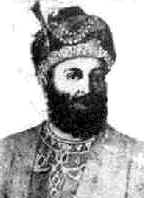
Mahmud Shah Durrani ; 1769 – April 18, 1829), also known as Shah Mahmud, or Mahmud Shah Abdali, was born a Prince and later became the ruler of Durrani Empire (Afghanistan) between 1801 and 1803, and again between 1809 and 1818. From 1818 to 1829, he was the ruler of Herat. An ethnic Sadduzai tribe section of the Popalzai sub clan of the Durrani Pashtuns, he was the son of Timur Shah Durrani and grandson of Ahmad Shah Durrani.
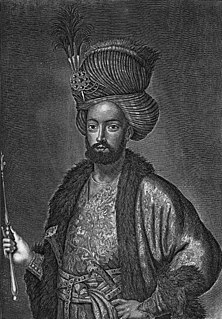
Sultan Husayn was the Safavid Shah of Iran (Persia) from 1694 until he was overthrown in 1722 by rebellious marauder Mahmud Hotaki, a Pashtun of the Hotak dynasty. His reign saw the downfall of the Safavid dynasty, which had ruled Persia since the beginning of the 16th century.

The Afsharid dynasty was an Iranian dynasty that originated from the Turkoman Afshar tribe in Iran's north-eastern province of Khorasan, ruling Iran (Persia) in the mid-eighteenth century. The dynasty was founded in 1736 by the brilliant military commander Nader Shah, who deposed the last member of the Safavid dynasty and proclaimed himself as the Shah of Iran.

The Hotak dynasty was an Afghan monarchy founded by Ghilji Pashtuns that briefly ruled portions of Iran and Afghanistan during the 1720s. It was established in April 1709 by Mirwais Hotak, who led a successful revolution against the declining Persian Safavid empire in the region of Loy Kandahar in what is now southern Afghanistan.

The Battle of Damghan or Battle of Mehmandoost was fought on September 29 to October 5, 1729, near the city of Damghan. It resulted in an overwhelming victory for Nader and the Safavid cause he had taken up, though by itself it did not end Ashraf's rule in Iran, it was a significant triumph which led to further successes in the following engagements of the campaign to restore Tahmasp II to the throne. The battle was followed by another one in Murcheh-Khort, a village near Isfahan. Nader's forces were victorious in both battles, which led him to remove the Ghilzai Afghan dynasty from their short stay on the Persian throne. The Hotakis were forced back to their territory in what is now southern Afghanistan.

Mirwais Khan Hotak, (1673–1715), was an Afghan ruler of Hotak dynasty from the Khilji tribe from Kandahar, Afghanistan and the founder of the Hotak dynasty that ruled from 1709 to 1738.

Nader Shah Afshar was the founder of the Afsharid dynasty of Iran and one of the most powerful rulers in Iranian history, ruling as shah of Iran (Persia) from 1736 to 1747, when he was assassinated during a rebellion. He fought numerous campaigns throughout the Middle East, the Caucasus, Central and South Asia, such as the battles of Herat, Mihmandust, Murche-Khort, Agh-Darband, Yeghevard, Khyber Pass, Karnal and Kars Because of his military genius, some historians have described him as the Napoleon of Persia, the Sword of Persia, or the Second Alexander. Nader belonged to the Turkoman Afshar tribe, a semi-nomadic tribe settled in Khorasan in northeastern Iran, which had supplied military power to the Safavid dynasty since the time of Shah Ismail I.
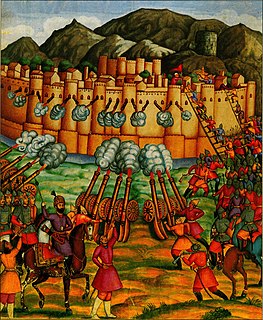
The Siege of Kandahar began when Nader Shah's Afsharid army invaded southern Afghanistan to topple the last Hotaki stronghold of Loy Kandahar, which was held by Hussain Hotaki. It took place in the Old Kandahar area of the modern city of Kandahar in Afghanistan and lasted until March 24, 1738, when the Hotaki Afghans were defeated by the Persian army.

The Ottoman–Persian War was a conflict between the forces of the Safavid Empire and those of the Ottoman Empire from 1730 to 1735. After Ottoman support had failed to keep the Ghilzai Afghan invaders on the Persian throne, the Ottoman possessions in western Persia, which were granted to them by the Hotaki dynasty, came under risk of re-incorporation into the newly resurgent Persian Empire. The talented Safavid general, Nader, gave the Ottomans an ultimatum to withdraw, which the Ottomans chose to ignore. A series of campaigns followed, with each side gaining the upper hand in a succession of tumultuous events that spanned half a decade. Finally, the Persian victory at Yeghevard made the Ottomans sue for peace and recognize Persian territorial integrity and Persian hegemony over the Caucasus.

The campaigns of Nader Shah, or the Naderian Wars, were a series of conflicts fought in the early to mid-eighteenth century throughout Central Eurasia primarily by the Iranian conqueror Nader Shah. His campaigns originated from the overthrow of the Iranian Safavid dynasty by the Hotaki Afghans. In the ensuing collapse and fragmentation of the empire after the capture of the Iranian capital of Isfahan by the Afghans, a claimant to the Safavid throne, Tahmasp II, accepted Nader into his service. After having subdued north-west Iran as well as neutralising the Abdali Afghans to the east as well as turning Tahmasp II into a vassal, Nader marched against the Hotaki Afghans in occupation of the rest of the country. In a series of incredible victories the Afghans were decimated and Tahmasp II returned to the throne as a restored Safavid monarch.

The Conquest of Khorasan by Safavid loyalist forces against separatists in Khorasan was Nader's first major military campaign which he waged on behalf of the new Safavid pretender to the throne, Tahmasp II. It would propel him into the centre of the political landscape of war torn early eighteenth century Persia.
The Battle of Sangan was an engagement involving the Loyalist forces of Tahmasp II of Safavid Iran led by Nader and the Abdali Afghan Tribes in and further beyond southern Khorasan in the autumn of 1727. This armed struggle was one of the initial battles between the resurgent Safavid cause and that of the Afghans. The engagement technically ended in a Safavid victory.

The Campaign of Herat consisted of a series of intermittent and fluid engagements culminating in the finale of Nader's military operations against the Abdali Afghans. Nader having recently concluded a successful campaign against his own monarch and prince, the badly humiliated Tahmasp II, set out from Mashad on 4 May 1729, making sure that the Shah also accompanied him on this journey where he could be kept under close supervision.
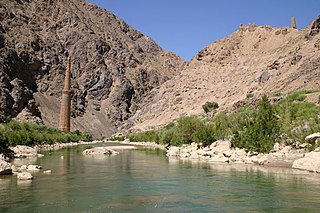
The Battle of Kafer Qal'eh was a series of clashes which decided the outcome to the Herat Campaign. In its culminating stage the battle bears some resemblances to the battle of Sangan although it was both preceded and succeeded by numerous other minor skirmishes and engagements.

The restoration of Tahmasp II to the Safavid throne took place in the latter part of 1729 by a series of battles fought between Nader, Tahmasp's commander-in-chief and Ashraf Hotaki. Despite nominally bringing Tahmasp to the seat of power, true authority still rested with Nader who had ever since the debacle in northern Khorasan managed to seize Tahmasp II as his vassal. As for Afghan rule, the Ghilzai Afghans were ejected from the Iranian Plateau permanently and in the following years were re-annexed by Nader whence they were once again absorbed into the Persian empire.

The campaign of 1731 was a failed attempt by Tahmasp II of the Safavid dynasty to launch an offensive into Ottoman held Caucasus which ended in a disastrous defeat with all of Nader's gains during the previous year being lost. The result of this particular military catastrophe was still overturned with Nader's return from the east but would have much more significant impact on the Safavid dynasty itself as Tahmasp II sealed his own fate by initiating this ill fated expedition.

After the succession of setbacks the Abdalis of Herat had faced in the campaign Allahyar Khan decided to sully out for a last engagement to decide the issue. Unfortunately yet again the charge of the Afghan horsemen was broken up by the disciplined fire of the Persian line musketeers and flank attacks by the supporting Persian cavalry. Allahyar Khan was left no choice but to withdraw his battered army behind the walls of Herat in the hopes of withstanding the coming siege. An intense bombardment of the city ensued with heavy cannon and mortars battering the city's defences. After consulting with his advisers Allahyar Khan was convinced of the futility of further resistance. Peace terms were offered and the Abdalis agreed to sear fealty to Tahmasp II as the rightful ruler of Persia and Herat. Thus the Abdalis were brought under Persian suzerainty.
The Rebellion of Sheikh Ahmad Madani was a revolt in the Garmsirat region of Iran from January 1730 as the Hotaks were being pushed out of Iran up until May 1734 when Sheikh Ahmad Madani was captured., although the rebellion continued until the middle of June 1734 before it was finally crushed.
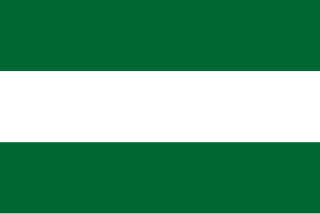
The Principality of Herat, the Emirate of Herat, the Herat Khanate or simply Herat was a state in Afghanistan from 1793 to 1863, and one of the 3 main khanates in 19th century Afghanistan.


















